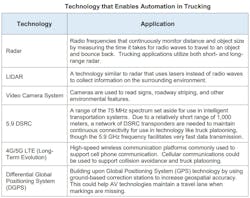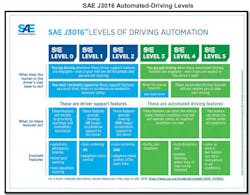Patchwork of self-driving laws limiting autonomous truck innovations
Self-driving trucks could change how freight moves across the United States. But with a slow-moving federal government and a patchwork of local laws regulating autonomous truck testing, that future is far from seamless, according to a recent study by the American Transportation Research Institute (ATRI).
The government rules created to support autonomous truck development are often too prescriptive to generate meaningful outcomes, according to the research. For example, multiple vendors highlight Level 4 testing, despite regulations that require constant control of the vehicles by both drivers and onboard engineers — making it difficult for motor carrier executives to assess the real value of autonomous trucks accurately.
The week before ATRI released its research paper, Redefining the Role of Government Activities in Automated Trucking, U.S. Transportation Secretary Elaine L. Chao was at CES 2020 in Las Vegas to unveil the fourth version of of the DOT's automated vehicle vision.
"We see in the displays at CES, on America's roads and in our skies such exciting transportation advancements that are occurring," Chao said during a keynote address at the Las Vegas Convention Center. "Transportation today is synonymous with innovation. And transportation is going to be instrumental in America's future, as it has been, since our nation's founding. And at the U.S. Department of Transportation, we are preparing for the transportation system of the future. And all of this speaks to our preparations for the future transportation system that will make all of our lives easier, more enjoyable, and increase the standard of living for everyone."
Ensuring American Leadership in Automated Vehicle Technologies: Automated Vehicles 4.0 (AV 4.0), a joint report by the DOT and National Science & Technology Council, attempts to ally automated vehicle efforts across 38 federal departments, independent agencies, commissions, and executive offices of the President. Among its goals is to provide high-level guidance to state and local governments, innovators, and all stakeholders on the U.S. government's approach towards AVs.
"The pace of technology development in the autonomous truck sphere is moving at lightning speed," said Jeff Reed, president of Skyline Transportation and chairman of the ATA Automated Truck Subcommittee. "Our industry needs states to collaborate on seamless policies and regulations, and we need more proactive federal guidance on (autonomous truck) development. Government activities at all levels must be dynamic enough to address the constantly evolving technology landscape."
With vast swathes of rural, less populated areas, both the U.S. and China are prime testing grounds for self-driving trucks, noted ZF CEO Wolf-Henning Scheider during CES. His company is working with a yet-to-be-named truckmaker to develop Level 4 automation by the middle of the decade.
But in the U.S., a lot of those less-populated states don't have laws about autonomous vehicles — and those that do can vary from border to border, making it difficult to truly test and plan for cross-country freight transport by self-driving trucks.
ATRI notes the "potential safety and economic benefits of adopting AV and cooperative operation technologies in the trucking industry are substantial." But because federal and state policymakers "have struggled to keep pace with the development of these technologies," the U.S. has a fragmented and incomplete ecosystem for developing, testing, and deploying self-driving trucks.
This splintered system "has likely hindered the development and adoption of AV and ADAS technologies in the trucking industry," according to ATRI.
The DOT's "hands-off approach" to AV testing has contributed to this piecemeal approach across the country, ATRI research contends. This could be a reason why there has not been much autonomous long-haul freight testing.
One of the leaders in self-driving truck technology, Plus.ai, recently completed a coast-to-coast freight run, that the company called the first Level 4 autonomous cross-country commercial haul of perishable cargo in the U.S.
The tractor-trailer traveled primarily in autonomous mode from California to Pennsylvania in less than three days. During the 2,800-mile trip, the truck passed through varied terrains and weather conditions across Interstates 15 and 70. A safety driver was on board at all times, and an engineer was present to monitor Level 4 autonomous system operations.
Most interstate autonomous truck testing is confined to the Southwest as part of the I-10 Corridor Coalition, which is made up of the state DOTs in California, Arizona, New Mexico and Texas. But as technology improves, ATRI expects the testing to be expanded to less temperate climates such as the Midwest, where DriveOhio has recently invited Plus.ai to test out self-driving trucks in the Buckeye State.
"The smart mobility ecosystem we've established in Ohio is a premier testing ground for autonomous vehicles," Patrick Smith, interim executive director of DriveOhio, said during CES 2020. "Ohio is excited to welcome leading autonomous trucking companies like Plus.ai to test at our state-of-the-art facilities and infrastructure."
Plus.ai, which was exhibiting at CES, said it will be selecting other new testing sites and states by the spring as it ramps up self-driving truck implementation this year.
ATRI concludes its research report by noting that there are still unaddressed policy questions "that are likely to delay the adoption of these transformative technologies in the trucking industry." And while it acknowledges that states have the right to create AV policies to ensure safe roadways, "it is incumbent upon federal and state policymakers to avoid implementing policies that needlessly delay testing or deployment of technologies that improve roadway safety."
Getting to that automated-vehicle future, as Secretary Chao noted at CES, requires a lot of cooperation. "This kind of innovation requires appropriate government oversight to ensure safety, open market, strategic allocation of public resources and of course, protection of the public interest," she said. "Realizing the vast potential of AV will require collaboration and information sharing among industry partners, state and local governments, academia, nonprofits, standards development organizations, and of course, the 38 different federal government agencies, independent commissions and departments."
About the Author
Josh Fisher
Editor-in-Chief
Editor-in-Chief Josh Fisher has been with FleetOwner since 2017. He covers everything from modern fleet management to operational efficiency, artificial intelligence, autonomous trucking, alternative fuels and powertrains, regulations, and emerging transportation technology. Based in Maryland, he writes the Lane Shift Ahead column about the changing North American transportation landscape.





